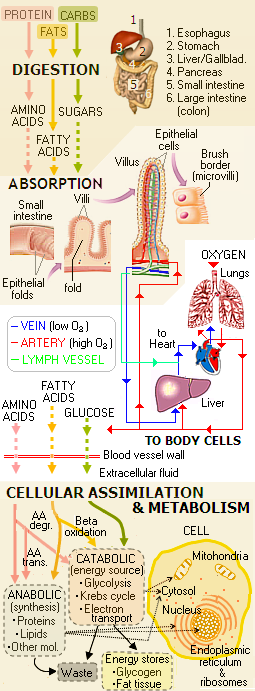|
■
Home ■ site map |
|
Body metabolism
Body metabolism - Cellular metabolism
Sugars
Amino
acids It appears very simple to define: body metabolism is the totality of physiological and biochemical processes supporting its function. More simply, it is the body chemistry that supports life. The two main branches of the metabolic cycle are catabolism - the breakdown of complex compounds or molecules, into simpler ones - and anabolism, the synthesis of needed more complex compounds and molecules from simpler ones. Specific chains of reactions through various metabolic stages are called metabolic pathways. These chemical reactions are made possible by enzymes, most of which first have to be synthesized by the body. The entire process is regulated by the nervous system, mainly via catabolic and anabolic hormones. Also, metabolic processes are often self-regulating, that is, the regulating signal can also be the level of a specific key metabolite itself. The entire body metabolism depends on only three "simple ingredients": food, water and oxygen. The former two supply raw material needed for body's structural and functional needs. The latter is needed for the final step in energy production at the cellular level. While the body always has "fuel molecules" available - if no other, it can use its own tissue - it cannot burn them for energy without oxygen. Since it cannot store it, we have to keep breathing.
Fuel molecules, as well as raw materials for
the myriad of molecules
needed for body's function and regeneration, are supplied by the
food we eat. In the first catabolic stage, large, complex molecules of proteins, fats and
carbohydrates - so called polymers - are broken down into smaller molecules,
or monomers, by the
digestive process.
These initial catabolic reactions are carried out by digestive enzymes. Digested food molecules become available for absorption by the cells of the inner intestinal lining (epithelium), passing them to the bloodstream. Blood collected from the intestinal vessels streams into the portal vain, which takes it to the liver. There, it is filtered from impurities and detoxified, before it is taken via hepatic artery to the heart, which pumps it out to the lungs, to take in the oxygen. Oxygen-and nutrient-rich blood from the lungs returns to the heart, from which it now heads to nourish cells throughout the body. Digested food molecules and oxygen are forced out of capillaries by hydrostatic (blood) pressure into extracellular fluid, and assimilated by the cells. This is where the second catabolic stage - breakdown of monomers - is taking place. Inside the cell, the two basic metabolic processes are taking place simultaneously: catabolic pathways harvest energy from molecular bonds through complex chemical manipulation of fuel molecules (monosaccharides, fatty acids and carbon skeletons of deaminated - i.e. stripped off their amino group - amino acids) supplied by food, while anabolic pathways, using energy created by catabolic reactions, use or synthesize needed basic molecules like amino acids (by transfer of amino groups, so called transamination), fatty acids and sugars to build larger, complex molecules - proteins, glycoproteins, lipoproteins, and others - needed for maintaining structural and functional integrity of the cell. In general, new polymers - protein, fat and sugar molecules needed by the cell - are synthesized from monomers obtained from food, either directly, or by re-arranging their molecular structure. Monomers burned for energy are, in effect, oxidized to water and carbon dioxide. All these processes are catalyzed by many thousands of highly specialized cellular enzymes. From this very basic level builds up the architecture of the human body, seemingly effortlessly uniting its five basic functions: acquiring, distributing, protective, regulatory and motor. So let's take a closer look at the foundation of what we are - cellular metabolism. YOUR BODY ┆ HEALTH RECIPE ┆ NUTRITION ┆ TOXINS ┆ SYMPTOMS |

